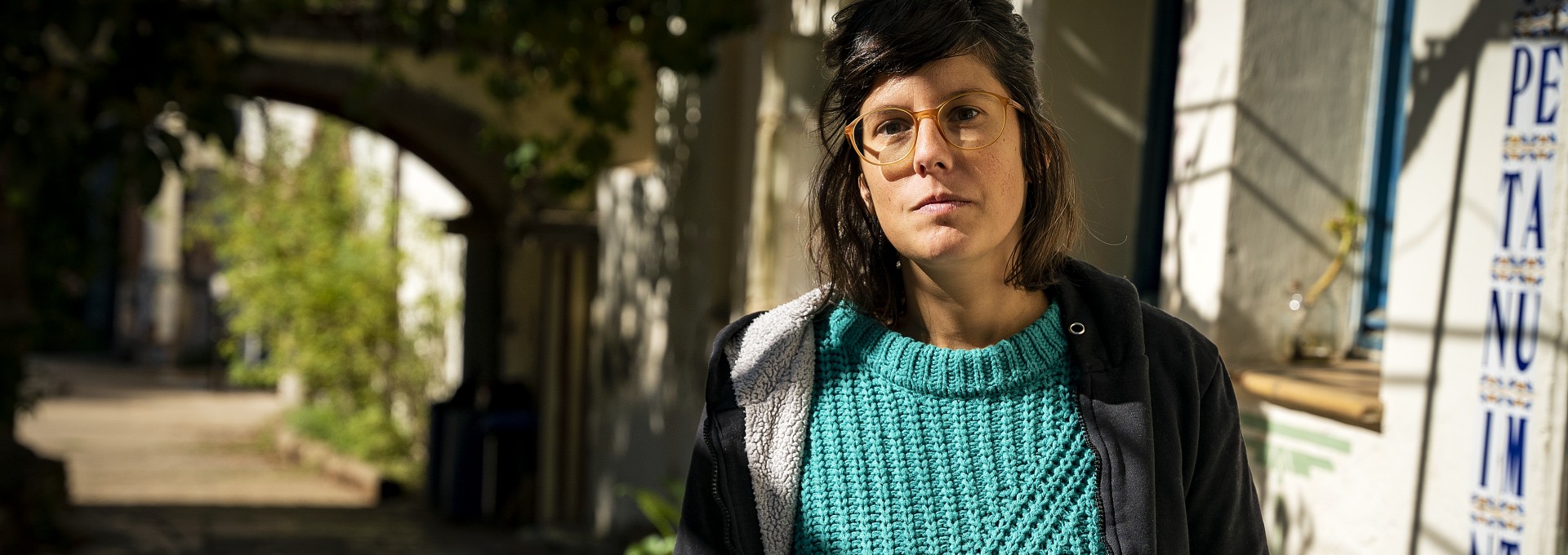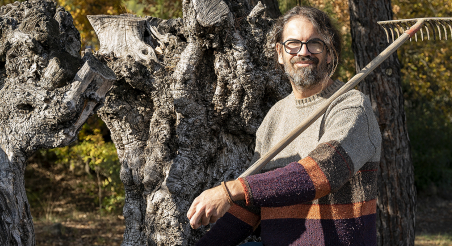Can Serrat is an old renovated farmhouse located in El Bruc, in the heart of Montserrat Rural Park. It operates as a space for living and coworking for artists and writers. Founded in 1989 by twelve Norwegian artists, it has since become a reference space for people seeking community living and enriching their creative projects with new perspectives and collaborations.
Since June 2020, they have opened their doors to people from all professional fields looking for a place to stay and work remotely. They believe that this dialogue can help develop the projects of international artists and writers who come to the farmhouse through their residency program. It also benefits local professionals who find themselves in a facility filled with people who can contribute to their growth.
As a result of this opening, new connections with the territory have emerged. Now there is a cooperative of consumers of organic and local products, a social garden project, and an art and nature festival, among other initiatives that promote a connection with the immediate environment. We discuss all of this with Sophie Blais, director of Can Serrat and the protagonist of the new short film of the 'BCN Smart Rura Stories'.
What is Can Serrat?
Can Serrat is a farmhouse in the village of El Bruc, at the foot of Montserrat mountains. It is over three centuries old and, for the past 30 years, has been hosting creative individuals, mainly artists and writers, through a residency program that operates with two annual calls. Recently, we opened the house to professionals from other disciplines who are interested in living here, and the mix that has been created is very interesting. We also host a cooperative of consumers of local food and have a large garden where we organize many public events, including our annual festival.
The owners of the house are Norwegian artists, and indeed, Can Serrat has a long history as a cooperative working space among internationally oriented artists. Do you think it is a unique project in Catalonia?
It is one of the oldest, but it is not unique: in rural Catalonia, there are several residencies focused on artistic creation. And like us, these places are increasingly working with the nearby territory, especially on projects related to sustainability.
«We are increasingly working with the nearby territory, especially on projects related to sustainability» Sophie Blais
Do you stay in touch and collaborate among yourselves?
During the pandemic, we had to close like everyone else, and we took the opportunity to rethink the project and incorporate new proposals. One of them was to open Can Serrat as a rural co-living and co-working space. Another was REMOTA, a remote residency program that, thanks to new technologies, allows us to offer spaces for reflection, encounters, and dialogue with artists who live far away. We also participated in 'Terra, Teca, Traca,' a collaborative proposal among seven artists' residencies in different rural areas of Catalonia. Together, we worked on the production of a traveling exhibition and debate sessions to engage the public in reflecting on the future of agri-food systems in the face of global environmental changes and the defense of agroecology. The project was coordinated by the University of Girona, the UOC (Open University of Catalonia), and the magazine 'Sobirania Alimentària,' and it was developed in the context of the celebrations of Barcelona as the World Capital of Sustainable Food.
Now that you've been able to reopen the international residency program, how has your vision changed? What projects do you have in progress?
Primarily, we have decided to invite artists and writers to stay with us for longer periods, and we now offer residencies of five months. We also continue to host a cooperative of consumers of local and organic products called Roca Verda. It was already operating before COVID-19, but during the pandemic, we were able to keep working with producers, and thanks to this continued relationship, we have generated some training activities, such as teaching composting or making homemade soap. Additionally, one of the residents of Can Serrat, who is an anthropologist, decided to turn our garden into a social project that allows us to work with schools, young people, refugee groups, etc. We want them to understand how the land works, how native plants of Montserrat are recovered, how they multiply, etc.
At Can Serrat, professionals can share a workspace and a place to live. Why did you decide to go beyond coworking and embrace coliving?
Basically, because, due to the pandemic, it became clear that many people wanted to leave the city and work in a more rural environment. But they not only wanted to come here to work: the house attracted them so much that they wanted to stay. Living at Can Serrat allowed them to enjoy the experience more intensely and get a better understanding of the territory.
How do artists, residents, coworkers, the external community, etc., integrate into the same space?
With many conversations. Keep in mind that at Can Serrat, we have from people who come for a month to stable residents who stay for a year or more. We have people who only speak Spanish, people who speak Catalan, and others who only speak English. We have people living here, people coming to work, and people from the village who come to Can Serrat once a month to participate in the open dinners we organize or the book club. So, we talk a lot among ourselves to understand the needs and dynamics of each individual and learn to tolerate these differences.
We assume that many artists who come to Can Serrat through your residency program are probably looking for a quiet space to create. How do you reconcile this need for calm and concentration with community living?
Well, as I mentioned before, with potentially conflicting conversations. But I think the path to resolving these conflicts is very interesting and often fuels literary and artistic production. I believe that communal living enriches, rather than hinders, creative processes.
«The path to resolving these conflicts is very interesting and often fuels literary and artistic production» Sophie Blais
Do you think the local people have understood the project?
I cannot speak for the people of the village, but I have the feeling that our relationship with the inhabitants of El Bruc is good. In fact, caring for this relationship is something we have in mind every day. We want to connect with the neighbours, encourage them to use the space, and participate in the activities we organize, both at the house and in the village.
What does being in the Montserrat Rural Park bring? What are the benefits of living and working in an environment like this?
Above all, arriving at Can Serrat is changing pace. It's erasing everything that happened before and starting to flow with the life you see around you. And it's perceiving time in a different way, without looking at the clock so much.
«Above all, arriving at Can Serrat is changing pace. It's erasing everything that happened before and starting to flow with the life you see around you. And it's perceiving time in a different way, without looking at the clock so much» Sophie Blais
And you, how did you come to Can Serrat? What life experiences led a Frenchwoman like you to a space like this?
I came to Catalonia in 2014, and at that time, I only spoke French and English. I was traveling in my van, taking photos with a pinhole camera, and I stumbled upon Can Serrat by chance. I loved the project and fell in love with the place, but I went back to France to join my job at an art center. I stayed in touch with the team managing Can Serrat at that time, and they asked if I wanted to collaborate with them. I informally started making some proposals that materialized, and at some point, they asked if I would be interested in managing the space. I accepted the challenge, although initially, it was challenging because I didn't speak Catalan or Spanish, and I didn't have time for classes. Fortunately, the people of El Bruc helped me a lot, and I learned these languages by socializing in the village.
What is the day-to-day life like at Can Serrat? What would someone who comes here in the morning experience?
First, we wake up slowly and have coffee in the kitchen, where we will likely encounter someone who is already awake. Then, we go into the garden and take a walk on the surrounding paths. When we return, we start working wherever we prefer, as some people work in their studios, outside, in the garden, or directly in the mountains. It is also important to note that at Can Serrat, we don't force anyone to work; it's okay if someone doesn't want to create. And that's how the day goes, with people casually meeting in different corners of the farmhouse and spending two hours talking about something that happened to them. These chance encounters are very pleasant! We usually gather for dinner, and it's common for someone to propose a recipe from their home country to the other residents, and together we cook and share a dish we've just discovered.
How has participating in the 'Rural Innova' action of the BCN Smart Rural strategy benefited Can Serrat? What kind of support have you received, and how do you value this initiative?
The guidance from BCN Smart Rural has been very useful and much-needed, and I have a very positive evaluation of it. Essentially, they helped us when we wanted to combine the coliving project with the artist residency and needed to learn about other similar projects and understand how to set it up in the simplest way.
As the director of Can Serrat, what are the dreams and future projects you would like to realize?
Above all, I would like to secure a budget to give more visibility to the diversity of people who live and work here and who undertake projects that are often very necessary for society.
On a personal level, have you stopped doing photography to focus on management? Is artistic creation compatible with running a project like Can Serrat?
Those of us driving this project are putting our entire lives and energy into it, and in a way, Can Serrat is our production. Can Serrat is a collective creative project that we care for in the same way an artist or writer cares for their work. Understanding that there are no clear boundaries between creation and management avoids any frustration.
— BCN Smart Rural Editorial —



